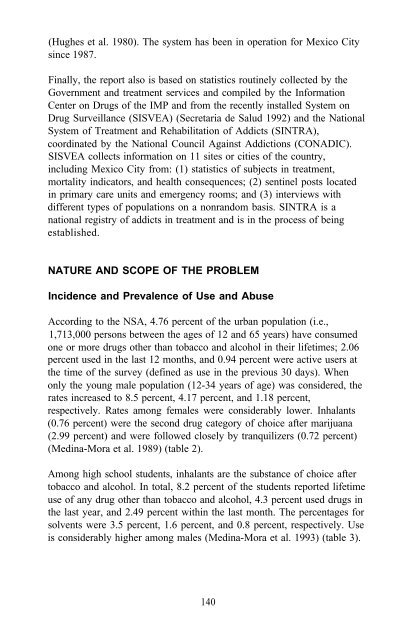Epidemiology of Inhalant Abuse - Archives - National Institute on ...
Epidemiology of Inhalant Abuse - Archives - National Institute on ...
Epidemiology of Inhalant Abuse - Archives - National Institute on ...
You also want an ePaper? Increase the reach of your titles
YUMPU automatically turns print PDFs into web optimized ePapers that Google loves.
(Hughes et al. 1980). The system has been in operati<strong>on</strong> for Mexico City<br />
since 1987.<br />
Finally, the report also is based <strong>on</strong> statistics routinely collected by the<br />
Government and treatment services and compiled by the Informati<strong>on</strong><br />
Center <strong>on</strong> Drugs <str<strong>on</strong>g>of</str<strong>on</strong>g> the IMP and from the recently installed System <strong>on</strong><br />
Drug Surveillance (SISVEA) (Secretaria de Salud 1992) and the <str<strong>on</strong>g>Nati<strong>on</strong>al</str<strong>on</strong>g><br />
System <str<strong>on</strong>g>of</str<strong>on</strong>g> Treatment and Rehabilitati<strong>on</strong> <str<strong>on</strong>g>of</str<strong>on</strong>g> Addicts (SINTRA),<br />
coordinated by the <str<strong>on</strong>g>Nati<strong>on</strong>al</str<strong>on</strong>g> Council Against Addicti<strong>on</strong>s (CONADIC).<br />
SISVEA collects informati<strong>on</strong> <strong>on</strong> 11 sites or cities <str<strong>on</strong>g>of</str<strong>on</strong>g> the country,<br />
including Mexico City from: (1) statistics <str<strong>on</strong>g>of</str<strong>on</strong>g> subjects in treatment,<br />
mortality indicators, and health c<strong>on</strong>sequences; (2) sentinel posts located<br />
in primary care units and emergency rooms; and (3) interviews with<br />
different types <str<strong>on</strong>g>of</str<strong>on</strong>g> populati<strong>on</strong>s <strong>on</strong> a n<strong>on</strong>random basis. SINTRA is a<br />
nati<strong>on</strong>al registry <str<strong>on</strong>g>of</str<strong>on</strong>g> addicts in treatment and is in the process <str<strong>on</strong>g>of</str<strong>on</strong>g> being<br />
established.<br />
NATURE AND SCOPE OF THE PROBLEM<br />
Incidence and Prevalence <str<strong>on</strong>g>of</str<strong>on</strong>g> Use and <str<strong>on</strong>g>Abuse</str<strong>on</strong>g><br />
According to the NSA, 4.76 percent <str<strong>on</strong>g>of</str<strong>on</strong>g> the urban populati<strong>on</strong> (i.e.,<br />
1,713,000 pers<strong>on</strong>s between the ages <str<strong>on</strong>g>of</str<strong>on</strong>g> 12 and 65 years) have c<strong>on</strong>sumed<br />
<strong>on</strong>e or more drugs other than tobacco and alcohol in their lifetimes; 2.06<br />
percent used in the last 12 m<strong>on</strong>ths, and 0.94 percent were active users at<br />
the time <str<strong>on</strong>g>of</str<strong>on</strong>g> the survey (defined as use in the previous 30 days). When<br />
<strong>on</strong>ly the young male populati<strong>on</strong> (12-34 years <str<strong>on</strong>g>of</str<strong>on</strong>g> age) was c<strong>on</strong>sidered, the<br />
rates increased to 8.5 percent, 4.17 percent, and 1.18 percent,<br />
respectively. Rates am<strong>on</strong>g females were c<strong>on</strong>siderably lower. <str<strong>on</strong>g>Inhalant</str<strong>on</strong>g>s<br />
(0.76 percent) were the sec<strong>on</strong>d drug category <str<strong>on</strong>g>of</str<strong>on</strong>g> choice after marijuana<br />
(2.99 percent) and were followed closely by tranquilizers (0.72 percent)<br />
(Medina-Mora et al. 1989) (table 2).<br />
Am<strong>on</strong>g high school students, inhalants are the substance <str<strong>on</strong>g>of</str<strong>on</strong>g> choice after<br />
tobacco and alcohol. In total, 8.2 percent <str<strong>on</strong>g>of</str<strong>on</strong>g> the students reported lifetime<br />
use <str<strong>on</strong>g>of</str<strong>on</strong>g> any drug other than tobacco and alcohol, 4.3 percent used drugs in<br />
the last year, and 2.49 percent within the last m<strong>on</strong>th. The percentages for<br />
solvents were 3.5 percent, 1.6 percent, and 0.8 percent, respectively. Use<br />
is c<strong>on</strong>siderably higher am<strong>on</strong>g males (Medina-Mora et al. 1993) (table 3).<br />
140
















